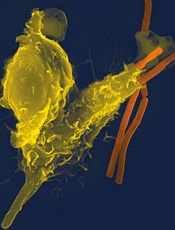
Image by Volker Brinkmann
LONDON—Immune cells may represent an important therapeutic target for preventing stent thrombosis, according to investigators from the PRESTIGE study.
The team analyzed more than 250 thrombus specimens and observed leukocyte infiltration in the context of early and late stent thrombosis.
Neutrophils were the most common leukocyte detected, and eosinophils were present in thrombi from all stent types.
The investigators reported these findings in the European Heart Journal and at the ESC Congress 2015 (abstract 1996*).
“Our results suggest that immune-cell-mediated thrombotic processes may be a realistic target for novel therapies to prevent [stent thrombosis],” said study investigator Steffen Massberg, PhD, of Ludwig-Maximilians University in Munich, Germany.
“Inhibition of triggers, such as extracellular nucleic acids activating the contact phase, may not only result in efficient anticoagulation in the setting of [stent thrombosis] but might also yield less therapy-associated bleeding. Future studies should evaluate whether inhibition of immune-cell-driven thrombotic pathways are effective and safe in clinical practice.”
The PRESTIGE study included patients with stent thrombosis who underwent thrombus aspiration at 9 centers in Europe between 2010 and 2014. In all, the investigators analyzed 253 thrombus specimens from these patients.
Seventy-nine specimens (31.2%) were from patients presenting with early stent thrombosis, and 174 (68.8%) were from patients with late stent thrombosis. Seventy-nine (31.2%) were from bare metal stents, 166 (65.6%) were from drug-eluting stents, and 8 (3.2%) were from stents of unknown type.
The thrombus specimens had heterogeneous morphology, with platelet-rich thrombus and fibrin/fibrinogen fragments being most abundant.
The investigators said leukocyte infiltrations were hallmarks of both early and late stent thrombosis, with neutrophils representing the most prominent subset. Neutrophils were found in similar amounts in early and late stent thrombosis.
“It is important to note that leukocyte counts were significantly higher compared with a control group of patients with thrombus aspiration in spontaneous myocardial infarction,” Dr Massberg said.
He and his colleagues also observed neutrophil extracellular traps (NETs) in 23% of samples.
And they found that eosinophils were present in all stent types, but there were higher numbers in patients with late stent thrombosis in sirolimus-eluting and everolimus-eluting stents.
“The presence of NETs supports their pathophysiological relevance in [stent thrombosis], while eosinophil recruitment suggests an allergic component to the process of [stent thrombosis],” Dr Massberg said.

*Information in the abstract differs from that presented.

